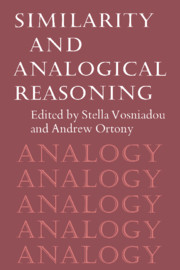Book contents
- Frontmatter
- Contents
- Preface
- List of contributors
- Similarity and analogical reasoning: a synthesis
- Part I Similarity and the structure of concepts
- Part II Analogical reasoning
- 7 The mechanisms of analogical learning
- 8 A computational model of analogical problem solving
- 9 Use of analogy in a production system architecture
- 10 Toward a microstructural account of human reasoning
- 11 Analogy and the exercise of creativity
- 12 Comments on Part II: Levels of description in information-processing theories of analogy
- 13 Comments on Part II: The role of explanation in analogy; or, The curse of an alluring name
- Part III Similarity and analogy in development, learning, and instruction
- Afterword: Comments on Parts I, II, and III: A framework for a theory of comparison and mapping
- Name index
- Subject index
10 - Toward a microstructural account of human reasoning
Published online by Cambridge University Press: 22 October 2009
- Frontmatter
- Contents
- Preface
- List of contributors
- Similarity and analogical reasoning: a synthesis
- Part I Similarity and the structure of concepts
- Part II Analogical reasoning
- 7 The mechanisms of analogical learning
- 8 A computational model of analogical problem solving
- 9 Use of analogy in a production system architecture
- 10 Toward a microstructural account of human reasoning
- 11 Analogy and the exercise of creativity
- 12 Comments on Part II: Levels of description in information-processing theories of analogy
- 13 Comments on Part II: The role of explanation in analogy; or, The curse of an alluring name
- Part III Similarity and analogy in development, learning, and instruction
- Afterword: Comments on Parts I, II, and III: A framework for a theory of comparison and mapping
- Name index
- Subject index
Summary
For the past several years my colleagues and I have been analyzing what we call parallel distributed processing (PDP) systems and looking at what we call the microstructure of cognition (cf. McClelland, Rumelhart, & the PDP Research Group, 1986; Rumelhart, McClelland, & the PDP Research Group, 1986). In this work we developed computational models of cognitive processes based on principles of “brainstyle” processing. The major focus of this work has been in perception, memory retrieval, and learning. The question remains as to how this work extends to the domains of “higher mental processes.” We have made one attempt to show how our PDP models can be used to account for schemalike effects (Rumelhart, Smolensky, McClelland, & Hinton, 1986). This chapter is designed to push those ideas further and to sketch an account of reasoning from a PDP perspective. I will proceed by first describing the basic theoretical structure of the PDP approach. I will then give a brief account of the reasoning process and finally show how it can be seen as resulting from a parallel distributed processing system.
Parallel distributed processing
Cognitive psychology/information processing has become the dominant approach to the understanding of higher mental processes over the past 25 years or so. The computer has provided, among other things, the primary conceptual tools that have allowed cognitive psychology to succeed. These tools have been powerful and have offered a conceptualization of mind that has proven both more rigorous and more powerful than any that have preceded it.
- Type
- Chapter
- Information
- Similarity and Analogical Reasoning , pp. 298 - 312Publisher: Cambridge University PressPrint publication year: 1989
- 28
- Cited by

